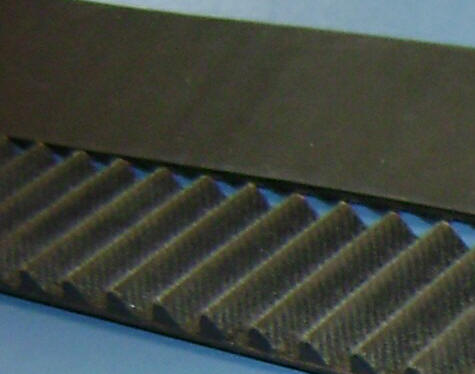Timing belt questions or need a quote? Contact us for more information. Replacement Intervals.
Timing Belts Keep things in Time
A Timing Belt, if left in long enough will eventually fail. This hidden component can cause a catastrophic side-of-the-road failure when it breaks.

If the synchronization between the crankshaft the camshaft is lost, the valves can come into contact with the pistons causing damage.
The timing belt is different than the rubber accessory belts used to transfer power from the engine to the cooling fan, alternator, power steering pump, and air conditioner.
In most cases these accessory belts can easily be inspected periodically for fraying or excessive wear, and are relatively easy to replace.
The engine timing belt is under a front engine cover and not easily viewed. If it breaks the engine will immediately shut down and it can cause far more damage than any of the other belts.
Timing belts keep the valves, pistons, and other internal engine parts properly synchronized.
The good news about timing belts is that they have very minimal stretch over their life, which means there is no need for periodic adjustments.
The bad news is that they eventually will weaken and break. The "cost" of a broken belt can be more than simply being stranded on the side of the road. Many of today's engines are manufactured to such extremely close tolerances that a broken timing belt can allow the pistons to hit the valves, bending the valves and in some cases destroying the pistons or even the complete engine as a result.
Timing belts often fail from the inside out, making visual inspection somewhat unreliable. We see perfectly looking belts that would have easily passed a visual inspection break very often (see bottom of page).
The main cause of belt wear is heat. As a belt wraps around and turns the sprockets, friction creates heat (this is in addition to the heat from the engine itself). Over time, this causes the rubber to lose flexibility. The cords inside the belt also weaken as the belt accumulates wear, increasing the risk of the belt breaking.
REPLACEMENT INTERVALS
This is why vehicle manufacturers recommend replacement of timing belts, typically every 60-105,000 miles or every 6 to 7 years (whichever comes first), although this varies among manufacturers and engine types.
(Always replace at 60,000 miles if car is regularly driven in temperatures near 110F, or -20F).
Timing belt replacement intervals can usually be found in your owner's manual. Interval guide for 2010 and older cars from Gates.
It is better to have this service done sooner than later as we have seen belts break ahead of the normal service interval, especially if the belt is older than 6 years old.
This once every four or five years investment is a small price to pay considering the alternatives, because when it comes to keeping your internal engine parts intact, timing is everything!
Make sure you use a quality timing belt. If the new belt fails prematurely, the belt manufacture will only warranty the belt, not the resulting engine damage that may occur.
These two pictures are of both sides of two different timing belts that were removed from cars. They look perfectly good, no visible wear or cracks on the cogged or the smooth side. But they aren't, click on one of the images to see.
See why these timing belts were replaced.
More to think about...
Timing belts have been around long enough that most people know they need to be replaced periodically. What your owner's manual doesn't tell you is that on many of today's engines, the timing belt drives the water pump. The water pump will usually outlast the first timing belt, but not usually the second.
What happens is about 15,000 to 30,000 miles later the water pump goes bad, sometimes ruining the timing belt. This may even bend valves.
Even if it doesn't destroy the timing belt and leave you sitting by the road, the timing belt still has to come off to replace the pump. The same thing can happen with the camshaft and crankshaft seals. The seals may be OK at the time, but if they fail in 10,000 miles, the timing belt job has to be repeated. It is not unusual to have the seals or pump fail within a year or two after a normally scheduled timing belt, due to the miles on the vehicle. It is a good idea to replace the seals while the belt is off, and if the pump is driven by the belt, replace it also.
Wayne's Garage
Automotive Service for Eugene and Springfield
333 Q Street in Springfield


